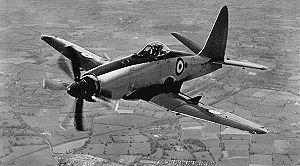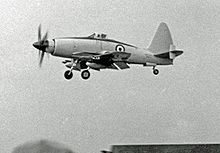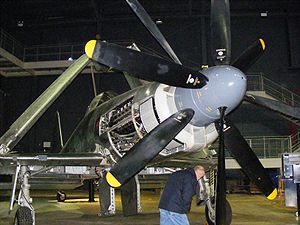Westland Wyvern Video - RC Model
|
|
Westland Wyvern
Wyvern

Picture - Wyvern S.Mk.4
Role: Carrier-based strike aircraft
Manufacturer: Westland Aircraft
Designed by: Teddy Petter
First flight: 12 December 1946
Introduced: 1953
Retired: 1958
Primary user: Fleet Air Arm
Produced: 1946-1956
Number built: 127
The Westland Wyvern was a British single-seat carrier-based multi-role strike aircraft built by Westland Aircraft that served in the 1950s, seeing active service in the 1956 Suez Crisis. Production Wyverns were powered by a turboprop engine driving large and distinctive contra-rotating propellers and could carry aerial torpedoes.
Design and development
The Wyvern began as a Westland project for a naval strike fighter, with the engine located behind the pilot and driving a propeller in the nose via a long shaft that passed under the cockpit floor. This enabled the pilot to be located in a position that conferred the best possible visibility over the nose for carrier operations. Official interest resulted in Air Ministry Specification N.11/44, for a long range naval fighter using the Rolls-Royce Eagle 22 24-cylinder H-block piston engine -Unrelated to the First World War-era engine of the same name-, being issued to cover Westland's design. The specification also called for an airframe design that would be able to take a turboprop engine as and when a suitable unit was available. There was a parallel specification for the Royal Air Force, F.13/44, for which Hawker submitted the competing P.1027; a development of the Tempest. The RAF variant was cancelled when in 1945 it was decided that all future fighter aircraft would be jet powered.

Picture - Wyvern S.4 strike aircraft of 813 Naval Air Squadron at RNAS Stretton in 1955
The original design soon matured into the more conventional Westland W.34, with the 3,500 hp (2,610 kW) Eagle engine in the nose driving large contra-rotating propellers and the pilot sitting high in a humped fuselage to improve visibility. The design was otherwise orthodox, with a low wing, tail-wheel undercarriage and double-folding wings fitted with both Youngman flaps on the inner wing section and conventional flaps on the outer section. The W.34 was to be armed with four Hispano 20 mm cannon in the wings and have the ability to carry a torpedo under the fuselage or a selection of bombs and rockets under the wings.
The prototype W.34; the Wyvern TF Mk 1, first flew on 12 December 1946 with Westland's test pilot Harald Penrose at the controls. This aircraft was lost on 15 October 1947 when the propeller bearings failed in flight. Westland's assistant test pilot Sqn. Ldr. Peter Garner was killed attempting to make an emergency landing. From prototype number 3 onwards, the aircraft were navalised and carried their intended armament.

Picture - Wyvern TF.2 being demonstrated at the Farnborough Air Show in 1953 by a Westland pilot
At around this time, the Eagle engine was cancelled and it was found that there were insufficient pre-production engines available to complete all the prototype and pre-production aircraft. Specification N.12/45 was therefore issued for the Wyvern TF.Mk.2, to be powered by a turboprop engine: either the Rolls-Royce Clyde or the Armstrong Siddeley Python. A single Clyde-powered prototype was ordered along with two with Pythons. A Clyde-powered TF 2 first flew on 18 January 1949. Both the piston powered and turboprop versions shared many common components including wing and tail units, and essentially, the basic cockpit structure. The flight was cut short to only three minutes when shortly after takeoff, the cockpit filled with smoke from a fuel leak onto the exhaust ducting. The Clyde was cancelled after only 50 hours of flight time for the TF 2, and the aircraft was delivered to Napier & Son to be fitted with the Nomad turbo-compound engine. However, the latter never became reality, and this aircraft was used for crash barrier trials.
The first Python-powered TF.2 flew on 22 March 1949 and this aircraft introduced the ejection seat to the Wyvern. Twenty TF.2s were completed to the Python design although after three years of testing what was then a revolutionary aircraft design, a myriad of detailed aerodynamic changes resulted. The Python engine responded poorly to minor throttle adjustments, so control was exercised by running the engine at a constant speed and varying the pitch of the propellers. The aircraft was declared ready for service in 1952, but never reached an operational squadron.
The definitive Wyvern mark was the TF.Mk.4, later S.Mk.4. Initially, 50 Mark 4s were ordered and were joined by the last seven TF.2s, which were altered while still under construction. Mk.4s reached limited shore-based front line service in May 1953 with 813 Naval Air Squadron at RNAS Ford, replacing the somewhat similar (and equally troubled) Blackburn Firebrand. Several second line squadrons also received Wyverns around this time.
Total production was 127 airframes with 124 aircraft completed, as the last three Eagle piston engined airframes, VR138/VR140, were never completed.
Operational history
Carrier trials began on 21 June 1950 with the type entering service in May 1953. The Wyvern was in service with the Fleet Air Arm from 1954 to 1958. Wyverns equipped 813 Naval Air Squadron, 827 Sqn., 830 Sqn. and 831 Sqn. of the Fleet Air Arm.
In September 1954, 813 embarked with their Wyverns on HMS Albion for carrier-based service in the Mediterranean. The Wyvern soon showed a worrying habit for flameout on catapult launch; the high G forces resulting in fuel starvation. A number of aircraft were lost off Albion's bows and Lt. B. D. Macfarlane made history when he successfully ejected from under water after his aircraft had ditched on launch and been cut in two by the carrier. 813 did not return to Albion until March 1955 when the problems had been resolved.
830 Sqn. took the Wyvern into combat from HMS Eagle, flying 79 sorties during Operation Musketeer; the armed response to the Suez Crisis. Two Wyverns were lost to Egyptian light flak damage; both pilots of the downed aircraft successfully ejected over the sea, and were picked up by Eagle's search and rescue helicopter. The squadron returned to the UK on Eagle after this conflict and disbanded in January 1957. 813 was the last Wyvern squadron, disbanding on 22 April 1958.
All Wyverns were withdrawn from service by 1958: while in service and testing there were 68 accidents, 39 were lost and there were 13 fatalities; including two RAF pilots and one USN pilot.
Variants
W.34 Wyvern TF. Mk. 1 - Prototypes, six built and pre-production aircraft, seven built of 10 contracted.
W.35 Wyvern TF. Mk. 2 - The original production version, three prototypes and nine production aircraft built, further 11 were completed as S 4s.
W.38 Wyvern T. Mk. 3 - Two-seat conversion trainer. One prototype only. VZ739
W.35 Wyvern TF. Mk. 4 - The definitive version, 98 built (including 11 started as TF 2s). Re-designated S. Mk. 4
Survivors

Picture - The solem surviving Wyvern TR.1 at the Fleet Air Arm Museum
An unflown pre-production aircraft, the last to be fitted with the original Eagle piston engine, (serial number VR137) is on display at the Fleet Air Arm Museum in Yeovilton, England.
Operators
United Kingdom
Fleet Air Arm
700 Naval Air Squadron
703 Naval Air Squadron
764 naval Air Squadron
787 Naval Air Squadron
813 Naval Air Squadron
827 Naval Air Squadron
830 Naval Air Squadron
831 Naval Air Squadron
Specifications (Wyvern S Mk 4)
Data from Westland (Planemakers 2)
General characteristics
Crew: One
Length: 42 ft 3 in (12.88 m)
Wingspan: 44 ft 0 in (13.42 m)
Height: 15 ft 0 in (4.57 m)
Wing area: 355 ft² (33 m²)
Empty weight: 15,608 lb (7,095 kg)
Loaded weight: 21,200 lb (9,636 kg)
Max takeoff weight: 24,450 lb (11,113 kg)
Powerplant: 1x Armstrong Siddeley Python 3 axial flow turboprop, 3,667 hp (2,736 kW)
Propellers: Two four-bladed contra-rotating propeller
Performance
Maximum speed: 383 mph (613 km/h)
Range: 904 miles (1,446 km)
Service ceiling: 28,000 ft (8,537 m)
Rate of climb: 2,350 ft/min (11.9 m/s)
Wing loading: 60 lb/ft² (292 kg/m²)
Power/mass: 0.17 hp/lb (0.28 kW/kg)
Armament
Guns: 4x 20 mm Hispano Mk. V cannons in the wings
Rockets: 16x RP-3 underwing rockets or
Bombs: Up to 3,000 lb (1,364 kg) of bombs or one Mk-15/17 torpedo or sea mine
Comparable aircraft
Blackburn Firebrand
A2D Skyshark
Tupolev Tu-91
Bibliography
Blackbushe Aviation Research Group. A History of the Westland Wyvern. Camberley, Hampshire, UK: Blackbushe Aviation Research Group, 1973.
James, Derek N. Westland: A History. Gloucestershire, UK: Tempus Publishing Ltd, 2002. ISBN 0-7524-2772-5.
Mondey, David. Westland (Planemakers 2). London: Jane's Publishing Company, 1982. ISBN 0-7106-0134-4.
OvÄx”Äxk, Michal and Karel Susa. Westland Wyvern TF Mks. 1,2, T Mk.3, S Mk.4 (in English). Prague, Czechia: Mark 1 Ltd., 2003. ISBN 80-902559-9-X.
Smith, John T. "Wrath of a Mythical Monster: Westland Wyvern Operations in the Suez Campaign" Air Enthusiast #74, March/April 1998.
Sturtivant, Ray, Mick Burrow and Lee Howard. Fleet Air Arm Fixed-Wing Aircraft Since 1946. Tonbridge, Kent: UK: Air-Britain (Historians) Ltd., 2004. ISBN 0-85130-283-1.
"Westland W.34 Wyvern." Control Column, Official Organ of the British Aircraft Preservation Council, Volume 11, No. 8, November/December 1977.
"Westland Wyvern: Design and Development of the Navy's Turboprop Strike Fighter." (pdf) Flight, 15 June 1956. Retrieved: 21 December 2009.
Williams, Ray. Fly Navy: Aircraft of the Fleet Air Arm since 1945. London: Airlife Publishing, 1989, ISBN 1-85310-057-9.
Westland Wyvern Pictures and Westland Wyvern for Sale.
Living Warbirds: The best warbirds DVD series.
Source: WikiPedia